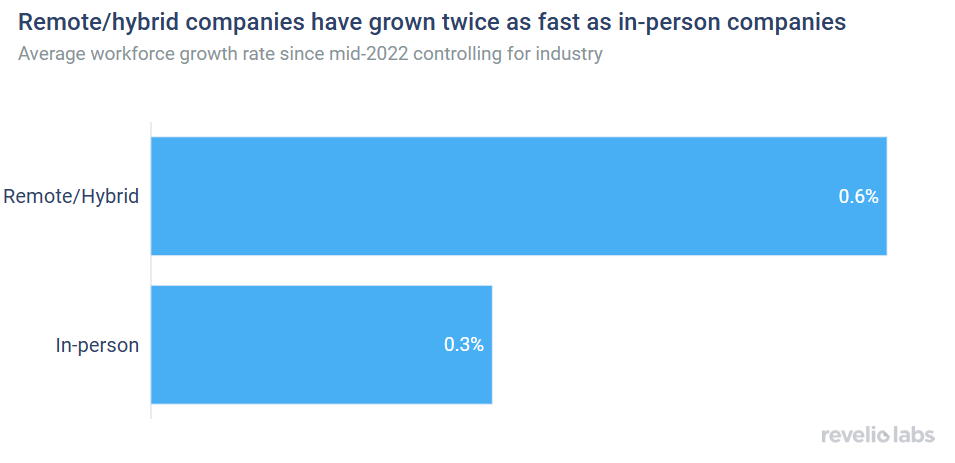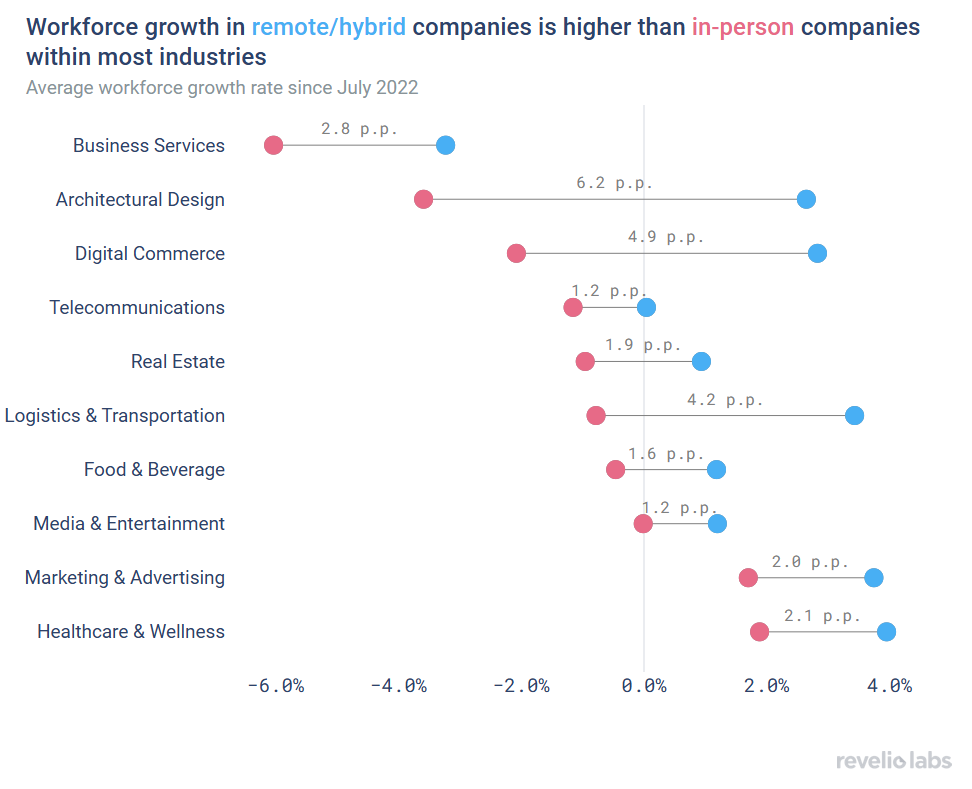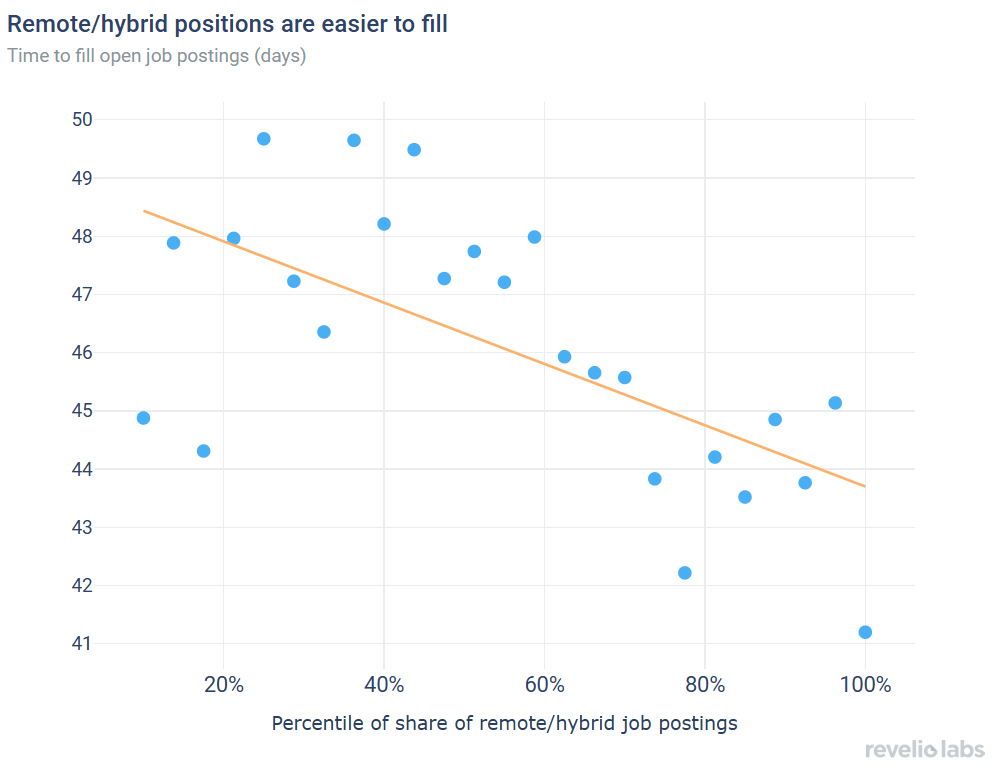Remote Companies Grow Twice as Fast
The case for rethinking RTO

Workforce growth in companies offering remote and hybrid work arrangements has outpaced that of in-person firms. When accounting for industry-specific effects, remote and hybrid companies have grown twice as fast as their in-person counterparts.
In most industries, companies embracing remote and hybrid work are better positioned to grow faster. The largest difference in workforce growth between remote and in-person companies is in the Digital Commerce and the Architectural Design industries.
Remote and hybrid job openings are correlated with faster times to fill open positions, indicating that firms that embrace remote and hybrid work are better positioned to attract the talent they need.
One of the last big pieces of corporate news in 2024 was AT&T mandating a return-to-office (RTO), requiring all office employees to work from the office five days a week starting in January 2025. AT&T’s announcement comes a few months after Amazon made a similar announcement in September 2024. Since mid-2022, executives have been pushing for RTO policies, citing reasons like building stronger company culture, fostering collaboration, and boosting productivity. However, research has consistently shown that the expected benefits of RTO policies are not always realized. In fact, numerous studies, including our own work at Revelio Labs, have found that remote work is often correlated with higher employee satisfaction, better work-life balance, and even lower attrition rates. We have also shown the benefits of remote work for sub-groups of the labor force, most importantly women. Similarly, other research has highlighted the high turnover for female employees, more senior employees, and more skilled employees as a result of mandating RTO.
This week, in collaboration with the Washington Post, we highlight an additional factor that companies should consider when implementing RTO policies: the impact on workforce growth. We focus on public companies in the US and categorize them as "remote and hybrid" or "in-person" using data from job postings. Companies where over 70% of job postings since mid-2022 have been advertised as remote or hybrid are classified as "remote and hybrid".
Our analysis shows that workforce growth in companies offering remote or hybrid work arrangements has consistently outpaced that of firms requiring employees to work in-person, even when accounting for differences across industries. Since mid-2022, companies requiring employees to work five days a week in the office have grown by an average of 0.3%, while those offering flexible work arrangements have grown at an average rate of 0.6%, or twice as quickly. These findings suggest that embracing remote work provides a competitive advantage in retaining and attracting talent, positioning such companies for stronger workforce growth.


The availability of remote and hybrid job opportunities varies significantly by industry. At the forefront are the Information Technology and Digital Commerce industries, where nearly half of all job postings since mid-2022 offer remote or hybrid options. These industries, driven by technology and digital infrastructure, have embraced remote work as a core feature of their operations. On the other end of the spectrum, industries like Design and Printing and Packaging Services have the lowest shares of remote or hybrid postings, as most roles often require physical presence, which limits the feasibility of remote work. But even for similar sets of activities, we have previously shown that some industries (and companies) are more open to the idea of remote work than others.
Within industries with a high share of remote and hybrid jobs, companies that remain fully in-person experience lower workforce growth rates compared to their remote and hybrid counterparts. Take, for instance, Digital Commerce: Remote and hybrid companies had an average workforce growth of 2.8% since mid-2022, while fully in-person companies had an average growth rate of -2.1%. This trend holds across most industries, highlighting the competitive advantage of offering remote or hybrid work options. Companies embracing remote or hybrid work are better positioned to attract and retain talent, regardless of the broader industry dynamics.


What might explain the slower workforce growth in in-person companies? Our previous research has shown a strong association between remote work and key engagement and productivity metrics, such as job satisfaction and work-life balance. These factors not only enhance employee retention but also make remote and hybrid roles more attractive to potential hires, easing recruitment challenges. They also allow companies to tap into a larger pool of talent that can be located far from the companies’ headquarters. Additionally, hiring for remote and hybrid positions is often faster and more efficient. Revelio Labs workforce data shows a strong negative correlation between company remoteness—i.e. the share of remote and hybrid jobs—and the time to fill open job postings. After controlling for roles, companies offering remote or hybrid work arrangements take an average of 42 days to fill an open position, compared to 45 days for companies requiring in-person work. This streamlined hiring process further contributes to the workforce growth advantage of remote and hybrid companies.


The evidence is clear: Embracing remote or hybrid work offers a competitive edge in workforce growth. Companies looking to attract and retain top talent should critically evaluate their remote work policies and explore ways to offer greater flexibility, even in industries where in-person work has traditionally been the norm. Expanding remote options allows organizations to tap into broader geographic talent pools, reaching skilled candidates who might otherwise be out of reach. Additionally, remote roles tend to fill faster, making the hiring process more efficient. Beyond recruitment, companies should prioritize tracking employee engagement metrics, such as job satisfaction and work-life balance, to ensure their policies are effectively supporting retention and productivity. Remote and hybrid work gives companies the opportunity to thrive in a competitive labor market while building stronger, more resilient teams.


